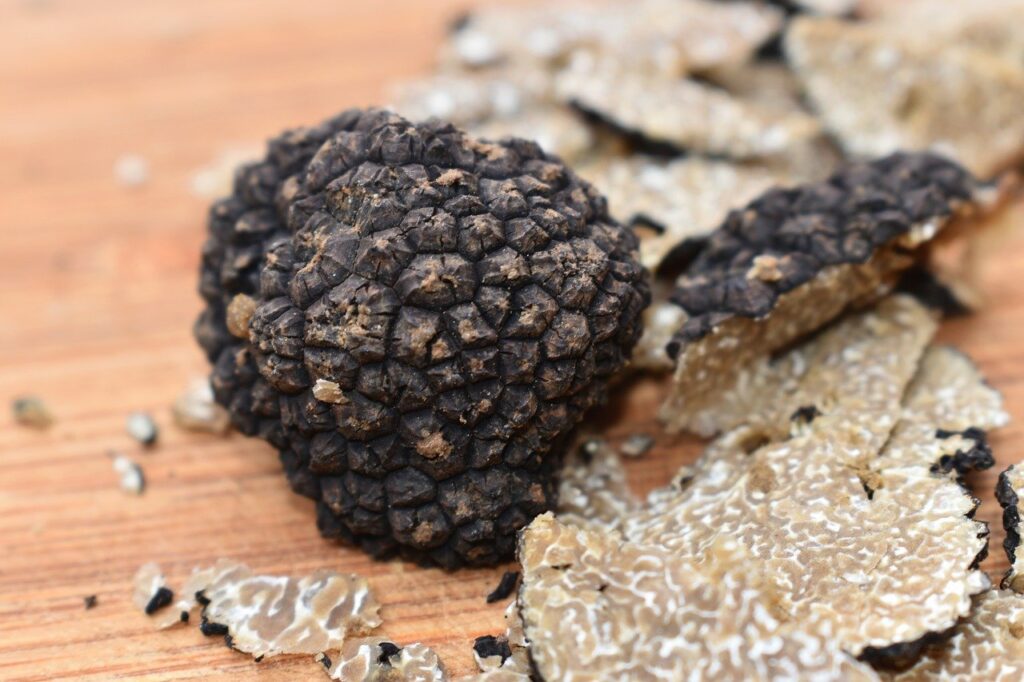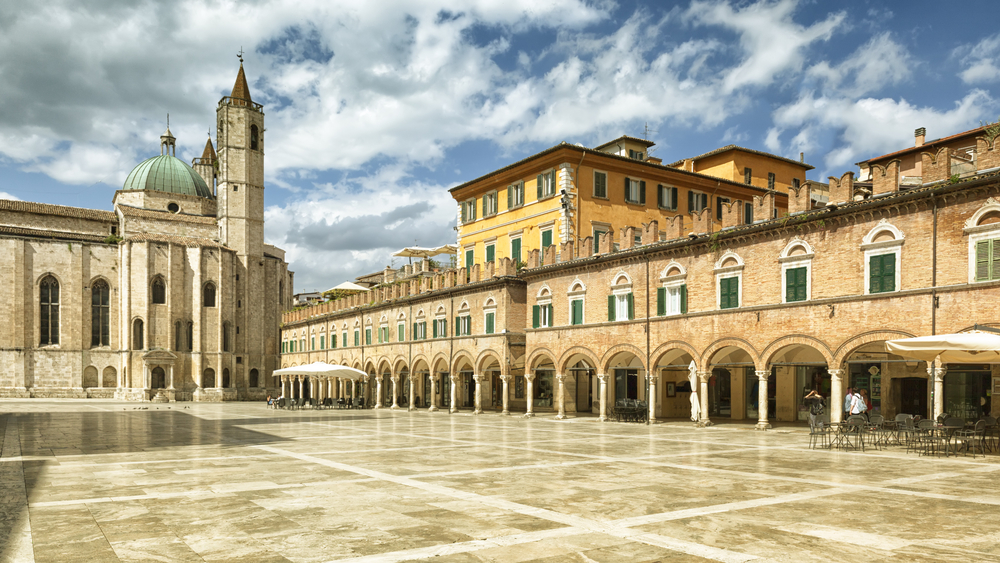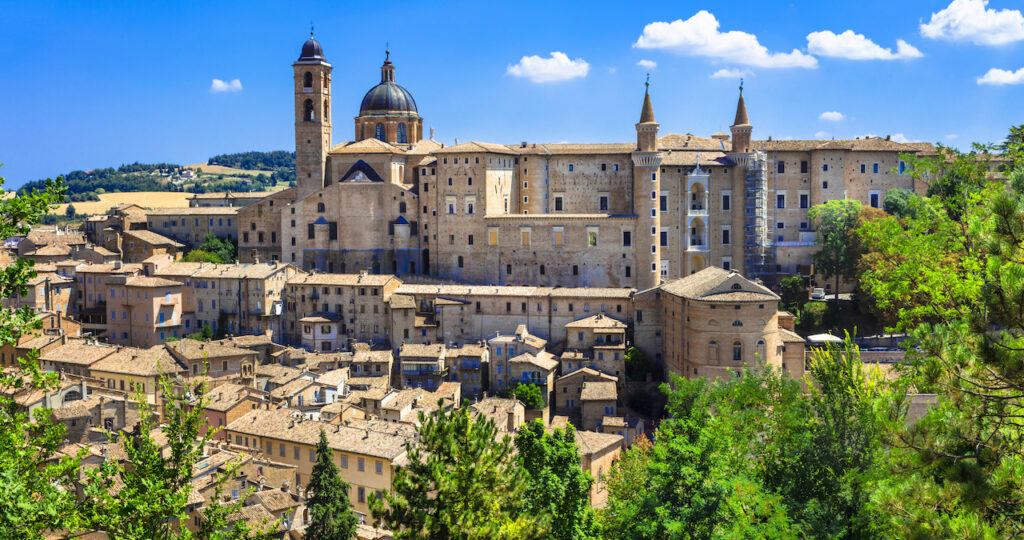10 reasons why you should visit Le Marche
Swathes of culture, incredible food and stunning landscapes – Italy doesn’t exactly make it easy when planning where to visit. From the city hubs, medieval hill-top towns to fishing villages, it’s a country with such an incredible variety of landscapes and places to visit.
If you’re looking for an unspoilt region of Italy, with minimal tourism yet all the culture and charm of the better-known regions, then we highly recommend that you visit Le Marche. BFY intern Domiziana explains why you should visit her much-loved home region:
LANDSCAPE VARIETY
Guido Piovene was the one to define this region as the “essence of Italy”; in 1956 when writing his famous work “Journey in Italy” he couldn’t find a better expression to describe the great variety of landscapes this region has. From the high mountains of the Apennine chains, which separate Le Marche from Tuscany, Umbria and Lazio, to the gentle hills descending towards 180 kilometres of coastline – Le Marche really does have it all.

You can go trekking on the famous Monti Sibillini, the highest mountains of the Umbro-Marchigiano Apennines. They’re part of a natural park and offer a wide variety of trails for those looking for nature, wildlife and stunning views. For those seeking adventure, it is possible to go rafting, canyoneering and mounting biking – or you could explore the famous Sybil’s cave. For lunch, you can stop in one of the many typical restaurants in the hilltop towns that characterise the central part of the region. Take a break for an authentic Italian lunch and stroll in the shadow of an ancient castle whilst admiring the gentle slopes around you.
Afternoons can be spent on one of the many sandy beaches on the coast of Le Marche; there are 16 which have been awarded with a blue flag for water and environmental quality. If you’re looking for some nightlife as well, Pesaro, Fano, Senigallia and San Benedetto del Tronto are probably the best options, while Sirolo, Numana and Grottammare will surprise you with their stunning coastline.
With just 90 kilometres from the mountains to the coast it could be possible to do all that in one – rather action-packed – day.
CULINARY EXCELLENCE
Italy is famous all over the world for its food and Le Marche is no different. Having such a variety of places, the culinary excellences of Le Marche offer a wide range of ingredients and flavours that will satisfy all tastes.

Many products come from the farming culture of the mountains and hills – mostly cheese, cold cuts, vegetables and wines. In Le Marche you will find a spreadable salami, Ciauscolo, the famous stuffed fried olives from Ascoli Piceno – Olive all’ascolana, the Casciotta di Urbino and Prosciutto di Carpegna, which have gained the important DOP label and are usually served with crescia sfogliata, a thicker and flaky version of piadina, as well as refined wines like Verdicchio di Matelica Riserva and Offida Pecorino or the extra virgin olive oil of Cartoceto. The passion of this region for good food is proved by the many festivals that are organised year-round even in the smallest towns, as well as by the fact that Le Marche are the home region of organic cultivation and food in Italy; it started in the 1970s with Gino Girolomoni, whose work now continues on the hilly town of Isola del Piano.
The true treasure of this region is then the truffle, both the precious white one and the strong black one called scorzone. Do not miss the opportunity to book a day out with a truffle hunter to discover all its secrets, or enjoy it in the typical dishes, especially with a particular type of pasta, passatelli.
The sea is also a great source of excellent food in this region: from the brodetto, a tasty fish soup that you can find in Fano, Porto Recanati and San Benedetto del Tronto, to the stockfish all’anconetana, which can be found in one of the Michelin star restaurants in Pesaro and Senigallia.
MADE IN ITALY
If we mention Cesare Paciotti, Diego della Valle and Piero Guidi, you’ll likely think about the luxury fashion shows in Paris or Milan. However, style and quality always go hand in hand with the tradition and hard work – and this is the case of Le Marche, the birthplace of these and many other handcrafted traditions. Post-WWII leather production resulted in first-class accessory companies including brands such as Tod’s, 4US and Magic Circus.
Tradition and quality are the key concepts around which the region’s products developed – whether fashion or furniture – and therefore a special mention must go to the handicraft creations that have been Le Marche’s distinctive sign for centuries. Among these is the traditional pottery production, which dates back to the Renaissance period and has Urbania as its capital, the world-famous paper of Fabriano, where tourists can discover all the ancient production techniques in the Museo della carta e della filigrana, and the unique accordion production in the little town of Castelfidardo.
DIALECTS
Italy is not just a mixture of landscapes, but it is also a mixture of cultures, lifestyles and languages. Italian became the national language only with the arrival of radio and television, which helped spread it all over the peninsula. Before that, people had spoken what are now called “Italian dialects”, but in many cases they are essentially different languages, which are still spoken in everyday life – so much so that Italians are often described as bilingual since birth.
Thirteen main dialect varieties have been identified and divided into three major categories, basically the northern dialects (gallo-italics dialects), the central dialects and the southern dialects. Le Marche is the only Italian region where dialects belonging to all of the three main categories are spoken, making it the linguistic epicentre of Italy.
HILLTOP VILLAGES
There is probably no better image for identifying Italy than a picturesque hilltop town surrounded by gentle slopes and cultivated fields, with the towers of a castle and the pinnacle of a cathedral rising towards the sky behind the medieval town walls. The central part of Le Marche offers a multitude of immaculately kept villages with these features, where tourists can take a plunge back to the Renaissance or Medieval times. Twenty-five Le Marche villages have been recognised as some of the “most beautiful villages in Italy” and twenty-one villages have been awarded with the orange flag as places of tradition and hospitality.

From the province county seats Fermo and Urbino, the last of which being one of the Italian UNESCO World Heritage Sites, to the small towns of Offida, Cingoli, Treia and Mondolfo, where you can admire imposing castles, go for a stroll on the cobbled streets of the centre and enjoy breath taking views over the landscape, Le Marche will certainly make you discover this small and authentic part of Italy. Do not miss the chance to visit Gradara, in the northern part of the region; not only it is one of the best kept medieval villages of the country but it also hosts the castle where the tragedy of the lovers Paolo and Francesca of Dante’s fifth canto from the Inferno actually occurred.
HISTORY
When you arrive for the first time in Le Marche you may not realise at first that this region has been the stage of important historic events that shaped the future of Italy and, in some cases, Europe.
Since the Roman Empire this territory was the ideal place for shipping towards East with Ancona, the Regional county seat, referred to as accessum Italiae, “the gate to Italy” by the emperor Traiano. The region also hosted one of the most decisive battles in the history of the Empire, which is recalled in the historical re-enactment “Battaglia del Metauro” every May. It was here that Hasdrubal was defeated by the Roman army, leaving his brother Hannibal alone in the war against Rome, which then resulted in the victory of the Empire against the Carthaginian invaders. Moreover, Le Marche is the birthplace of Frederick II, Emperor of the Holy Roman Empire, and one of the most important historical figures of the High Middle Ages.

The Renaissance was the real golden period for Le Marche, especially in the northern part of the region where the families Sforza, Malatesta and Montefeltro were fighting each other for the control of this territory. While the Sforza were the Lords of Pesaro and Gradara and had to deal with the inglorious Borgia family, the Montefeltro family ruled Urbino and with Federico III this small town became one of the most important centres in early Renaissance. With dozens of artists coming from all over Europe, the most praised ducal palace and library of that time, Urbino was described as “a city with the form of a palace” and a beacon of culture across Europe.
ART
Being one of the most important places for the early Renaissance and a region scattered with towns ruled by different lords and families, Le Marche will surprise you with their wide and refined artistic heritage.
Most of the works of marchigiani artists are now hosted in the Galleria Nazionale delle Marche in Urbino, where visitors can admire one of the famous “Ideal city” attributed to Luciana Laurana, as well as paintings by Piero della Francesca as the internationally-renowned “Flagellation of Christ” and “Madonna of Senigallia”.

The Tuscan painter spent a lot of time at the court of Federico da Montefeltro and the territory of the duchy, which inspired many of his works. If you take a tour in these places, you may recognise many of the backgrounds of Piero’s works, as well as the most discussed and intriguing painting backgrounds in the history of art, the one of Mona Lisa. According to some art experts the world’s most emblematic painting may not portray Lisa del Giocondo, a Florentine dame, but Pacifica Brandani, a noble woman from Urbino who was probably the lover of Giulinao de’ Medici. And if that were not enough to justify Le Marche artistic credentials, Raphael was a marchigiano. The indisputable leader of Renaissance painters was actually born in Urbino, where he created his first artistic works and where it is now possible to visit his birth house.
HOSPITALITY
It is not easy to talk about the local people, the marchigiani, in an univocal way… simply because there is not just one type of marchigiani, but dozens of them as there are dozens of dialects, traditions and passions. If the northern marchigiani are funny and love making jokes like the near locals from Emilia-Romagna, in the centre they tend to be more reserved but very warm. If in the coastline they are used to parties and festivals and will make you discover an all of its own kind of nightlife, on the mountains they are more used to a peaceful but authentic way of life. No matter where you are, marchigiani will surprise you with their hospitality; they may not be exuberant and talkative as the near people from Tuscany or Lazio, they will let have your space but they will always be there for you and if you tell them, they will share with you the passion they have for their regions and traditions.
LA DOLCE VITA
If you think about La dolce vita, you would probably recall the famous Fellini’s movie and that magic shots of Rome at night. However, this expression in Italian means “sweet life” and it refers to a way of conducting life without worries and appreciating the beauty that surrounds you. In Le Marche beauty is everywhere and the most extraordinary thing is that it is in the everyday life; we are not talking about the unspoilt landscapes or immaculate medieval towns, this time we are actually talking about the lifestyle of the people from this region, the way they live, the stunning places surrounding them with the peaceful, hard-working and optimistic attitude that characterises them.
A journey through Le Marche is not just a journey through art, history and beautiful spots, it is a way of learning how to appreciate the small things of ordinary life, enjoy the company of the people closest to you and truly understand what quality of life is. So relax, have a chat with your host in one agriturismo, have a glass of wine with your travel companions in a vineyard staring at the sea… and just enjoy how sweet life can be!
TRADITION
This is probably the word that better describes Italy, and especially Le Marche. A place of history and histories, of great artists and great handicraft productions, Le Marche summarises what Italy has always been famous for – tradition has an authentic and heart-felt meaning here. You can experience it in the many festivals and pali set up all over the region, where the ancient divisions between areas and contrade come out again in a joyful and playful way with Medieval attire.
Le Marche are the land of religious tradition as well, with abbeys like the Abbazia di Fiastra and hermitages as Fonte Avellana surrounded by nature and the town of Loreto being one of the main sites of Catholic pilgrimage: the cathedral, whose dome incorporates the style of Brunelleschi’s dome of Santa Maria del Fiore in Florence, hosts the Holy House of the Virgin Mary, which according to the tradition was brought to Loreto by the angels in the night between 9th and 10th December 1294.
Feeling inspired to visit Le Marche? Check out our villa rentals in Marche



